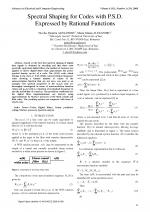| 1/2008 - 6 |
Spectral Shaping for Codes with P.S.D. Expressed by Rational FunctionsALEXANDRU, N. D. |
| Extra paper information in |
| Click to see author's profile in |
| Download PDF |
Author keywords
Codes, Digital filters, Linear predictive coding, Markov processes, Spectral analysis
References keywords
signals(4), digital(4), codes(4), alexandru(4)
Blue keywords are present in both the references section and the paper title.
About this article
Date of Publication: 2008-04-02
Volume 8, Issue 1, Year 2008, On page(s): 31 - 35
ISSN: 1582-7445, e-ISSN: 1844-7600
Digital Object Identifier: 10.4316/AECE.2008.01006
Web of Science Accession Number: 000259903500006
SCOPUS ID: 67749131182
Abstract
Based on the fact that spectral shaping of digital data signals is obtained by encoding and that there exist spectrally equivalent digital filters, the method of Justesen was applied to derive digital filters that approximate the power spectral density (p.s.d.) of a code. The (2,2,3) code, which belongs to the class of FAS (Finite Autocorrelation Sequence) codes showing a limited number of values of the autocorrelation function that are not zero, was used as an example. The spectral properties of the (2,2,3) code are thoroughly investigated in terms of autocorrelation function values and p.s.d. both as a function of normalised frequency fn and the probability of a mark p. The prediction coefficients for the digital filter implementations are derived using approximations by Markov processes of the third, fourth and fifth order. The resulting spectra are compared with those of (2,2,3) code. |
| References | | | Cited By «-- Click to see who has cited this paper |
| [1] G. L. Cariolaro and G Vannucchi, "Spectral density equivalent linear filter for a broad class of digital signals", Proc. of Internationl Conf. on Commun., San Francisco, pp.11-9-11.14, 1975.
[2] J. Justesen, "Information Rates and Power Spectra of Digital Codes", IEEE Transactions Inf. Theory, Vol.IT-28, No.3, May, pp. 457-472, 1982. [CrossRef] [Web of Science Times Cited 58] [SCOPUS Times Cited 58] [3] V. A. Dieuliis and F. P. Preparata, "Spectrum Shaping with Alphabetic Codes with Finite Autocorelation Sequence", IEEE Trans. on Comm., vol.COM-26, No.4, pp. 474-477, April 1978. [CrossRef] [Web of Science Times Cited 3] [SCOPUS Times Cited 5] [4] N. D. Alexandru. and G. Morgenstern. Digital Line Codes and Spectral Shaping, Editura Matrix ROM, Bucuresti, 1998 [5] N. D. Alexandru. and Dae Young Kim, "Spectral Shaping via Coding", CERMI, Iasi, 2003 [6] J. Justesen, "Calculation of power spectra for block coded signals", IEEE Trans. on Communications, Vol. 49, No 3, March, pp. 389-392, 2001. [CrossRef] [Web of Science Times Cited 4] [SCOPUS Times Cited 5] [7] N. D. Alexandru and C. Chatellier, "Extending the Calculation of Correlation Function for 1I - nO Block Coded Signals", Proc. of the Int. Symposium SCS'2003, Iasi, pp. 629-632, 2003. [8] J. G. Kemeny and J. L. Snell, "Finite Murkov Chains", Princeton, NJ: Van Nostrand, 1960. [9] G. L. Cariolaro and G. P. Tronca, "Spectra of block coded digital signals", IEEE Trans. Commun. Technol., vol. COM-22, pp. 1555-1563, Oct. 1974. [CrossRef] [SCOPUS Times Cited 102] [10] N. D. Alexandru, V. Cehan and L. Pancescu, "An Extended Method for Calculating the Autocorrelation Function for 1I-2O Codes Based on Entry and Departure Matrices", International Conference Communications'2000, Bucharest, Romania, pp. 55-58, 2000. Web of Science® Citations for all references: 65 TCR SCOPUS® Citations for all references: 170 TCR Web of Science® Average Citations per reference: 7 ACR SCOPUS® Average Citations per reference: 17 ACR TCR = Total Citations for References / ACR = Average Citations per Reference We introduced in 2010 - for the first time in scientific publishing, the term "References Weight", as a quantitative indication of the quality ... Read more Citations for references updated on 2025-06-01 06:04 in 29 seconds. Note1: Web of Science® is a registered trademark of Clarivate Analytics. Note2: SCOPUS® is a registered trademark of Elsevier B.V. Disclaimer: All queries to the respective databases were made by using the DOI record of every reference (where available). Due to technical problems beyond our control, the information is not always accurate. Please use the CrossRef link to visit the respective publisher site. |
Faculty of Electrical Engineering and Computer Science
Stefan cel Mare University of Suceava, Romania
All rights reserved: Advances in Electrical and Computer Engineering is a registered trademark of the Stefan cel Mare University of Suceava. No part of this publication may be reproduced, stored in a retrieval system, photocopied, recorded or archived, without the written permission from the Editor. When authors submit their papers for publication, they agree that the copyright for their article be transferred to the Faculty of Electrical Engineering and Computer Science, Stefan cel Mare University of Suceava, Romania, if and only if the articles are accepted for publication. The copyright covers the exclusive rights to reproduce and distribute the article, including reprints and translations.
Permission for other use: The copyright owner's consent does not extend to copying for general distribution, for promotion, for creating new works, or for resale. Specific written permission must be obtained from the Editor for such copying. Direct linking to files hosted on this website is strictly prohibited.
Disclaimer: Whilst every effort is made by the publishers and editorial board to see that no inaccurate or misleading data, opinions or statements appear in this journal, they wish to make it clear that all information and opinions formulated in the articles, as well as linguistic accuracy, are the sole responsibility of the author.



